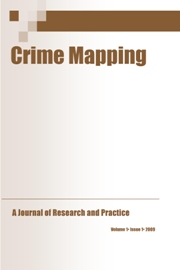

Crime Mapping: A Journal of Research and Practice
Co-Editors Timothy C. Hart, Ph.D. & Paul Zandbergen, Ph.D
• ISSN: 1942-0927 (Print) • ISSN: 2152-9876 (Online)
Keywords: Environmental Criminology, Crime Analysis, Space, Time, and Crime
Article Price: $18.99
Geospatial Modeling and Simulating Urban Property Crime
JAY LEE
Abstract | Pp. 65–80 |
Based on routine activities theory, deviant places theory, and the concepts of neighborhood life cycles, this paper describes the development and the functions of an Urban Crime Simulator (UCS). UCS was developed to estimate changes in property crime rates in urban neighborhoods as induced by projected changes in the characteristics of the neighborhoods. The developed simulator is fully integrated with GIS-formatted data and is operational in GIS environment. It enables users the flexibility of choosing neighborhood attributes that best fit their experience and knowledge of local neighborhoods. In addition, the selection of neighborhood attributes to be included in the simulation can be made based on particular criminological theories or expert experience that best fit localized trends.
Using the concepts of neighborhood life cycle, UCS first classifies urban neighborhoods into a number of clusters with minimized in-cluster variation and maximized between-cluster variation. When a target neighborhood is chosen and updated with projected changes in its attributes, UCS finds a reference neighborhood in the area that has the closest attribute profile with the changed profile of the target neighborhood whose property crime rates are being simulated. The estimated changes in crime rates for the updated neighborhood are derived from statistical analysis of the neighborhoods in the cluster that the most similar neighborhood belongs to.
PO Box 72742 • Las Vegas • NV • 89170
© CJ Research 2011-13

